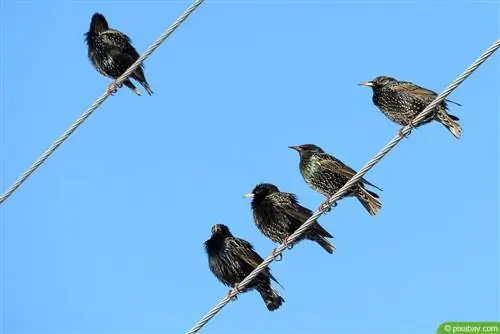- Author admin [email protected].
- Public 2023-12-17 03:39.
- Last modified 2025-01-24 12:45.
Native bird species, including the starling, are increasingly being pushed out of their habitat. Due to the high level of infrastructure and fewer and fewer nesting opportunities, it is not easy for starlings to care for their young. A nesting box that you can easily build yourself using the instructions can help here.
Instructions for building a “starling box”
Of course, this does not mean the speed camera colloquially known as a starling box, but rather a nesting box that supports the birds and encourages them to breed. In the garden, on open spaces and in urban outskirts, a nesting box can create a whole new habitat for local birds. It is important that the structure is tailored to the needs of starlings and adapted to their body size. The birds will accept the nesting box and soon there will be happy chirping in the garden.
Materials for the nesting box
Mostly wood is used for construction. The nest box builder can use either glued wood or natural wood. It is important that the wood has not been treated with insect repellents or other wood preservatives that are toxic to birds. You will also need nails and a little bit of roofing felt. A fretsaw or jigsaw and circular hole saw, a hammer and pliers are sufficient tools. So it's not difficult to build a breeding place for the starling using the specified materials and the appropriate tools and invite the birds to your own property. The nesting box consists of a base and lid, two side walls, a back wall and a front into which the entrance is cut into shape. You will also need a board to attach the nesting box.
Step by step instructions for construction
A nesting box for starlings should not be less than 25 cm high and 20 cm wide. First, the individual parts are measured, marked and sawn. With the following tips and measurements, you can build it precisely and accurately for starlings.
- Back wall 30×19 cm
- Front 26×15 cm
- Side panels 2x with 30x17x26 cm (shorter at the front than at the back)
- Floor 15×15 cm
- Roof 22×26 cm
So that rainwater does not accumulate on the roof, it is applied at an angle. This measure is served by the side walls, which have a height of 26 centimeters towards the front and a height of 30 cm towards the rear wall. The bevel can be easily achieved with a jigsaw. Since the front is also 26 centimeters high, the roof rests on both the back and the front. Once all components have been cut, the rear wall must be provided with a slight bevel on the top edge. This is the only way the roof can be installed without a gap and therefore absolutely tight and protected from the weather. In the upper third, a hole with a diameter of 45 millimeters is made using the circular hole saw. The hole must not be made too deep, otherwise the young starlings could reach it and fall out.
Assembling the nesting box

Roofing nails are best. They are long, easy to hit into wood and have a narrow head that poses no risk of injury to the birds. If a nail is hammered crooked into the wood, it can easily be removed with pliers. Under no circumstances should it remain in the nesting box, as the injury to young starlings and also to the mother would be enormous. The following order is recommended for assembly:
- Connect the back wall to the floor from behind (the floor is in the nesting box)
- Attach the strip for fastening, drive nails through from the inside or use screws
- Nail the side walls to the floor
- Place the front and connect it to the floor and side walls
- Put the roof on, fasten it with nails to the side walls, the front and the back wall.
If the nesting box is to be protected from premature weathering by roofing felt and made particularly moisture-resistant, you can now apply the roofing felt. This can be easily cut with scissors and should be one millimeter above the edge of the roof so that moisture cannot collect between the roofing felt and the wood. Roofing felt is easy to nail. Shorter nails can be used for this. Since the starling wants to go high, the nesting box should be installed at a height of at least 4 meters, and preferably even a little higher. The most beautiful nesting box will not be accepted if it is located immediately above the ground or within the gardener's line of sight.
Not only starlings will be convinced
A nesting box for starlings not only attracts them, but also the wryneck. This prefers the same nesting conditions as the starling and finds the structure just as interesting. In a large garden, it is therefore advisable not to just build a nesting box. Of course, the place where it should be hung is also important. With a minimum height of 4 meters and a quiet location in nature, it is guaranteed to be accepted. Under no circumstances should a nesting box be located too close to the house or a busy street. The constant unrest would disturb the birds while breeding and could result in the mother starling not returning to her young. Prying looks are also discouraged. Starlings need peace and seclusion in order to be able to care for their offspring and look after their offspring in peace. The gardener only sees the young birds when they make their first trip out of the nesting box and look around the garden.
What you need to pay attention to

The wood must not be treated and therefore not poisonous. Natural wood is therefore ideal. But glued wood is also suitable, as long as it is not subsequently treated with wood preservatives. However, the nesting box can be painted. A weather-resistant paint that is water-based is suitable for this. Children's toy varnish as well as other solvent-free varnishes can be used. Glazes, stains or solvent-based paints are dangerous for the starling and must not be used in a nesting box. Before hanging it up, check that there are no nails sticking out of the wood and protruding into the nesting box. The risk of injury to the starlings would be enormous and would go against the goodwill of the construction project.
What you should know about starling nesting boxes in brief
Starlings usually appear in larger groups. They are cavity nesters and like to use nesting boxes:
- The entrance hole in a starling box must be 45 to 50 mm in diameter.
- The nesting box should be secured in a cat-proof manner.
- The breeding space for a starling is better made a little larger.
- The base area for a nesting box should be approximately 16 x 16 cm.
There are quite newfangled nesting boxes commercially available for starlings. They look quite unusual, but offer several advantages for the animals. They provide good protection against predators such as magpies, jays and cats. The young birds can no longer be pulled out of the nesting box. This is because there is an anteroom in front of the actual entrance hole. This is closed off from the outside by a metal grille. The breeding area is therefore completely protected. This nesting box no longer has a perch, but it is not necessary. It only makes their job easier for the nest robbers.
- For starlings, it is absolutely necessary to clean the nesting boxes before the new breeding season.
- Dirty starling boxes will not be accepted. In addition, vermin and parasites can threaten the brood.
- Starling boxes should be hung with the entrance hole facing southeast to east. This location offers the nesting boxes the best protection from the weather.
Tip:
In general, only untreated wood is used for nesting aids.






